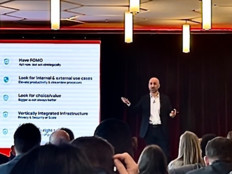Citing Microsoft research findings, Spataro noted that 80 percent of managers expect more flexible work from home policies after workplaces reopen, and that more than 70 percent of workers expect to take advantage of that. In 2020 alone, Microsoft Teams usage jumped to 115 million daily active users, and Microsoft 365 users generated 30 billion collaboration minutes in a single day.
Microsoft also rolled out more than 100 new Teams features in 2020, including:
- Large Gallery, which lets video meeting participants see up to 49 video feeds at once.
- Together Mode, which allows users to place meeting participants’ faces in a virtual shared space, such as an auditorium.
- Dynamic View, which lets users control who shows up alongside content as it’s shared.
- Virtual Breakout Rooms, allowing for the easy creation of subgroups.
- Connect, which enables the creation of Teams channels for people outside an organization.
- Webinar enablement within Teams, which will handle registration and scheduling and allow users to broadcast to as many as 20,000 attendees.
Microsoft Builds Solutions for Hybrid Meetings
Those updates are just the beginning, and they are designed primarily for meetings where all participants are remote. An immediate challenge for collaboration solution providers is how to maximize the hybrid meeting experience, in which some participants are physically in a conference room while others are calling in.
“Meeting rooms were originally created to enable in-room collaboration, so joining a meeting remotely can make you feel like you’re on the outside looking in,” Spataro said.
So Microsoft introduced Teams Rooms, an array of physical hardware — from Microsoft partners such as Lenovo, Crestron, Poly, Logitech and others, plus some of its own gear — that works with its Teams software features to create state-of-the-art meeting experiences for those in the room and those outside of it.
For example, those participating in a room can choose to see remote users together on a screen in any number of layouts. Smart cameras and microphones that frame and identify speakers, provide a live written transcript of what the speaker is saying, and even follow the speaker around the room, keeping him or her centered in the frame, will help remote attendees feel part of the action.
Moreover, with the Surface Hub 2S, Microsoft’s top-of-the-line digital whiteboard, in-room attendees can write or draw directly on the screen or via their computer or tablet, as can remote participants.
“We’ve seen exponential growth in things like real-time document sharing, but we know we still have to crack the code on virtual creativity,” Spataro said. “When it comes to things like brainstorming, people are still missing being in a room together.”
MORE FROM BIZTECH: Learn how dynamic technology enables a more flexible workforce.










